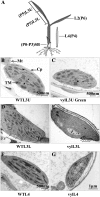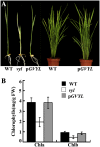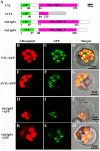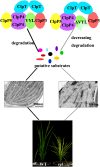A rice virescent-yellow leaf mutant reveals new insights into the role and assembly of plastid caseinolytic protease in higher plants
- PMID: 23803583
- PMCID: PMC3729767
- DOI: 10.1104/pp.113.217604
A rice virescent-yellow leaf mutant reveals new insights into the role and assembly of plastid caseinolytic protease in higher plants
Abstract
The plastidic caseinolytic protease (Clp) of higher plants is an evolutionarily conserved protein degradation apparatus composed of a proteolytic core complex (the P and R rings) and a set of accessory proteins (ClpT, ClpC, and ClpS). The role and molecular composition of Clps in higher plants has just begun to be unraveled, mostly from studies with the model dicotyledonous plant Arabidopsis (Arabidopsis thaliana). In this work, we isolated a virescent yellow leaf (vyl) mutant in rice (Oryza sativa), which produces chlorotic leaves throughout the entire growth period. The young chlorotic leaves turn green in later developmental stages, accompanied by alterations in chlorophyll accumulation, chloroplast ultrastructure, and the expression of chloroplast development- and photosynthesis-related genes. Positional cloning revealed that the VYL gene encodes a protein homologous to the Arabidopsis ClpP6 subunit and that it is targeted to the chloroplast. VYL expression is constitutive in most tissues examined but most abundant in leaf sections containing chloroplasts in early stages of development. The mutation in vyl causes premature termination of the predicted gene product and loss of the conserved catalytic triad (serine-histidine-aspartate) and the polypeptide-binding site of VYL. Using a tandem affinity purification approach and mass spectrometry analysis, we identified OsClpP4 as a VYL-associated protein in vivo. In addition, yeast two-hybrid assays demonstrated that VYL directly interacts with OsClpP3 and OsClpP4. Furthermore, we found that OsClpP3 directly interacts with OsClpT, that OsClpP4 directly interacts with OsClpP5 and OsClpT, and that both OsClpP4 and OsClpT can homodimerize. Together, our data provide new insights into the function, assembly, and regulation of Clps in higher plants.
Figures










Similar articles
-
A pair of homoeolog ClpP5 genes underlies a virescent yellow-like mutant and its modifier in maize.Plant J. 2014 Jul;79(2):192-205. doi: 10.1111/tpj.12568. Epub 2014 Jun 23. Plant J. 2014. PMID: 24888539
-
Identification and Characterization of a Plastidic Adenine Nucleotide Uniporter (OsBT1-3) Required for Chloroplast Development in the Early Leaf Stage of Rice.Sci Rep. 2017 Jan 30;7:41355. doi: 10.1038/srep41355. Sci Rep. 2017. PMID: 28134341 Free PMC article.
-
Identification of new protein substrates for the chloroplast ATP-dependent Clp protease supports its constitutive role in Arabidopsis.Biochem J. 2009 Jan 1;417(1):257-68. doi: 10.1042/BJ20081146. Biochem J. 2009. PMID: 18754756
-
Structure, function, and substrates of Clp AAA+ protease systems in cyanobacteria, plastids, and apicoplasts: A comparative analysis.J Biol Chem. 2021 Jan-Jun;296:100338. doi: 10.1016/j.jbc.2021.100338. Epub 2021 Jan 23. J Biol Chem. 2021. PMID: 33497624 Free PMC article. Review.
-
Plastid Nucleoids: Insights into Their Shape and Dynamics.Plant Cell Physiol. 2024 May 14;65(4):551-559. doi: 10.1093/pcp/pcad090. Plant Cell Physiol. 2024. PMID: 37542434 Review.
Cited by
-
Albino midrib 1, encoding a putative potassium efflux antiporter, affects chloroplast development and drought tolerance in rice.Plant Cell Rep. 2014 Sep;33(9):1581-94. doi: 10.1007/s00299-014-1639-y. Epub 2014 Jun 11. Plant Cell Rep. 2014. PMID: 24917171
-
Mapped clone and functional analysis of leaf-color gene Ygl7 in a rice hybrid (Oryza sativa L. ssp. indica).PLoS One. 2014 Jun 16;9(6):e99564. doi: 10.1371/journal.pone.0099564. eCollection 2014. PLoS One. 2014. PMID: 24932524 Free PMC article.
-
Oryza sativa Chloroplast Signal Recognition Particle 43 (OscpSRP43) Is Required for Chloroplast Development and Photosynthesis.PLoS One. 2015 Nov 23;10(11):e0143249. doi: 10.1371/journal.pone.0143249. eCollection 2015. PLoS One. 2015. PMID: 26600124 Free PMC article.
-
Combined Chlorophyll Fluorescence and Transcriptomic Analysis Identifies the P3/P4 Transition as a Key Stage in Rice Leaf Photosynthetic Development.Plant Physiol. 2016 Mar;170(3):1655-74. doi: 10.1104/pp.15.01624. Epub 2016 Jan 26. Plant Physiol. 2016. PMID: 26813793 Free PMC article.
-
Transferring an optimized TAP-toolbox for the isolation of protein complexes to a portfolio of rice tissues.Plant Mol Biol. 2016 Jun;91(3):341-54. doi: 10.1007/s11103-016-0471-x. Epub 2016 Mar 22. Plant Mol Biol. 2016. PMID: 27003905
References
Publication types
MeSH terms
Substances
LinkOut - more resources
Full Text Sources
Other Literature Sources
Molecular Biology Databases
Miscellaneous

